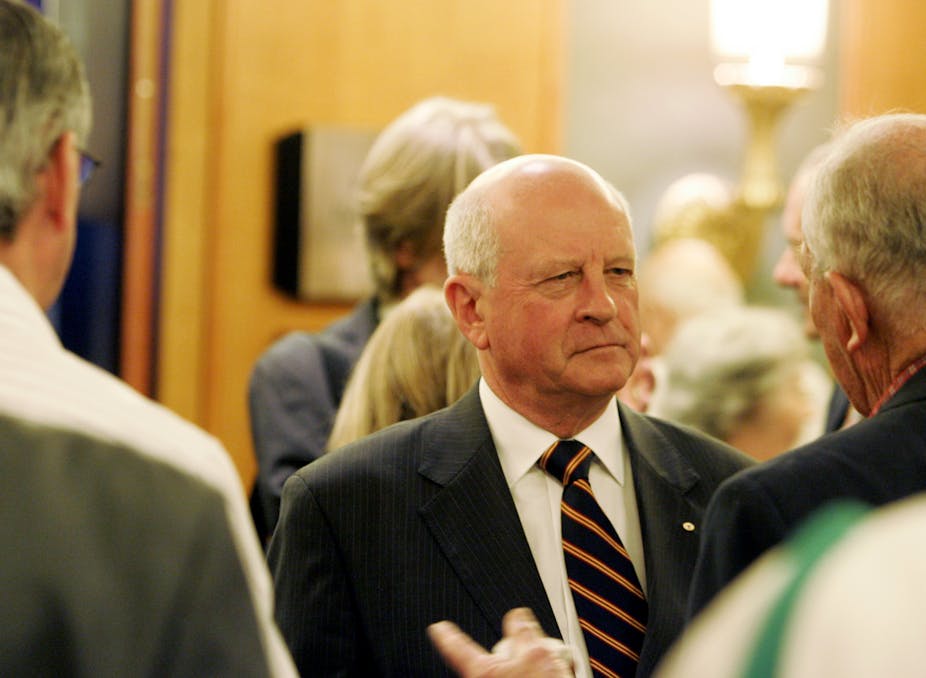The Fairfax Media AGM took place in Melbourne today against a backdrop of financial meltdown in the company’s fortunes. The share price — currently at 38 cents — has halved since the beginning of the year.
That’s not such bad news if the stock is actually worth something. But when the fall is from 80 cents to less than 40 cents, it’s a calamity piled onto a disaster.
However, you wouldn’t necessarily get that impression from the soothing opening remarks by chairman Roger Corbett, who told the small Melbourne audience of shareholders that despite the ravages of an “annus horribilis”, Fairfax Media is in good shape and in good hands.
Over the falls in a barrel
Corbett could make going over the falls in a barrel sound as safe and delightful as a pleasure cruise. Fairfax chief executive Greg Hywood followed up with a calm and lucid explanation of the new digital strategy.
But some shareholders were squirming as Hywood outlined a strategy of “structural change” that is designed to strip $235 million out of Fairfax’s costs, including cutting staffing levels by an average of 20% across the board and by 30% in the key metropolitan mastheads.
Hywood also reminded Fairfax investors that the strategy means closing two printing plants, moving to smaller compact formats and installing a metered paywall across online news assets.
Hywood’s performance resembled the classic serene swan gliding across a pond. What the swan keeps hidden is the frantic paddling that powers its smooth progress.
After listening to these opening speeches, you might think that the changes underway at Fairfax are the result of good business decision-making and represent a “steady as she goes” approach.
Nothing could be further from the truth. Fairfax Media is in financial meltdown. To put this into perspective, the share price has fallen by more than 90% since October 2007. The most recent high point was now more than a decade ago; the share price was $6.10 in March 2000. Fairfax shares have not been above $5.00 since April 2007 and since October 2008 they have not gone above $1.99. It’s been all downhill from the now deliriously good-looking $1.79 per share in March 2010.
The shareholders, the board, and the staff must miss those fabled “rivers of gold” that came with a near monopoly on classified advertising in the once-proud Fairfax newspapers.
What has gone so horribly wrong?
Well for a start, we stopped reading newspapers in huge numbers, and we don’t advertise in the classifieds much anymore. It also doesn’t look like Fairfax Media’s digital strategy is doing the company much short-term good either.
Print circulation is down in the latest figures available. Average weekly circulation for the SMH and The Age is down about 30,000 (or 15%). Where a comparison is possible with 2011, for example in tablet downloads and digital unique views, the numbers are moving in the right direction. Both show a big increase over last year, but in terms of net daily average digital circulation, the numbers for both mastheads are less than half of the print edition.
If Fairfax is going to turn its fortunes around, the number of digital subscribers must grow rapidly. Whether or not the pay curtain strategy that comes into play next year will improve bottom line is still a known unknown.
But as of this week, there is no good news for Fairfax Media investors. All of the key performance indicators are trending down from the last financial year. Cash flows from trading were down 15%; underlying EBITDA down 16.7%; after-tax profit down 25% and revenue down 6%.
On the back of these numbers, the value of the company was written down by some $2 billion in August this year. In his Chairman’s report during the annual reporting season, Roger Corbett indicated that the board had little confidence that the business would improve in the near future.
With so much to discuss — and with Australia’s richest woman lurking in the wings — we might have expected today’s AGM to be a seething racket, as disgruntled shareholders got stuck into a board that seems to be in stasis and unable to move ahead.
Paying for “success”?
In the build up to the meeting the most contentious issue was thought to be item 7 on the busy agenda – the levels of executive remuneration.
The Australian Shareholders Association led a campaign to have executive pay levels (including of chairman Corbett) reined in, and the two proxy advisory firms were split on the issue.
The ASA argued that Corbett, Hywood and the board had “presided over substantial destruction of shareholder value” over the last financial year and therefore should not be substantially rewarded at the expense of investors.
“It appears that shareholders have suffered a lot more financial pain than Mr Corbett,” the ASA wrote in its voting intention notes.
That would certainly appear to be the case; Roger Corbett “earned” over $400,000 for his efforts as chairman, and chief executive Greg Hywood was paid more than $2.6 million for working hard on delivering “structural change” at Fairfax.
The elephant in the room
The ASA was represented at the AGM by Stephen Mayne, who managed to ask a couple of embarrassing questions of Roger Corbett, but at the end of the day, the weight of history was on the side of the institutions.
Mr Corbett would not make any admissions of mistakes in the past, nor would he engage with Mayne’s questions about the competence of the board. Other small shareholders also commented on the trashing of shareholder value.
Former Labor senator, Chris Schott, hit the nail on the head when he noted that “in purely capitalist terms”, the efforts of the board and chief executive had been “an appalling performance”.
Schott also made reference to the “elephant in the room”. What is Gina Rinehart, the company’s biggest shareholder, up to?

